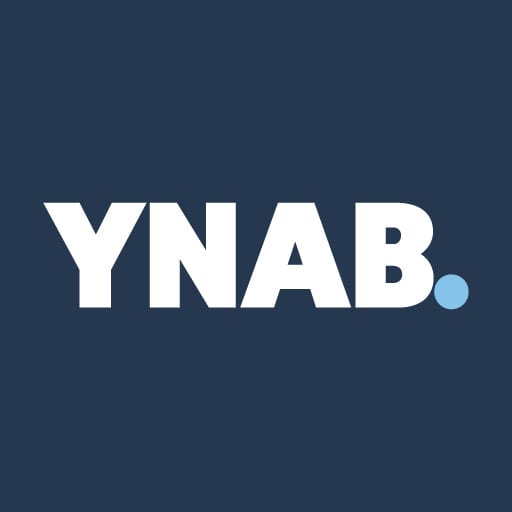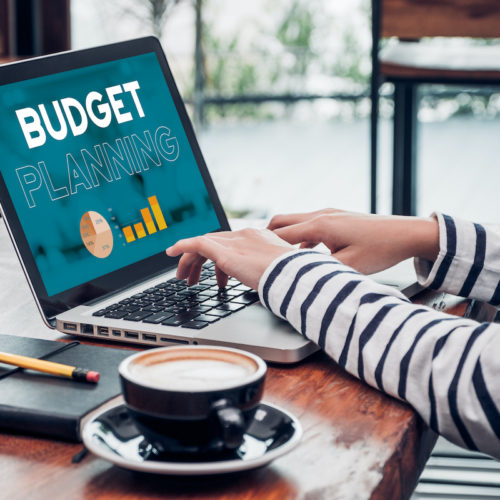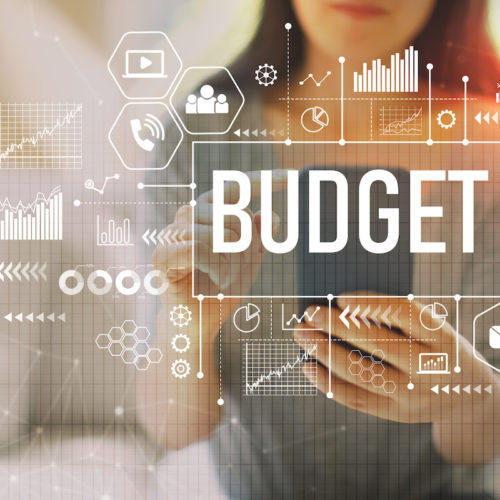Just about anyone can follow a budget for a month or two. But most people don’t stick with it for the long haul.
I know something about budgeting from my own transition from being broke to becoming a millionaire. Though I never made a formal monthly budget, I learned to keep my basic living expenses low. As a result, I saved an incredible percentage of my income – as much as 80 percent – just by living well beneath my means.
That’s what a budget can do for you.
Let’s concentrate on how to make a monthly budget. I’ll provide several options so you can implement one that will work best for you.
6 Steps To Creating a Budget
At its core, setting up a budget requires simple math spread across time. You could choose any time period, but most people make a monthly budget. This feels natural because many expenses recur monthly.
Here are the six basic steps to creating a successful budget:
1. Determine Your Monthly Disposable Income
You’ll start by determining your monthly income. That will require your net income – which is essentially your take-home pay. It ignores payroll deductions, such as income taxes, health insurance premiums, or retirement saving contributions.
This will give you an accurate picture of the disposable income you have available each month. It will also represent the upper limit of your budget. Your ultimate goal will be to spend less each month than your net income.
Now if you have an additional source of income, like a side hustle, you may or may not want to include this in your budget. If you include it, you’ll obviously have more room in your budget, but you’ll also need the side hustle to keep your budget alive.
Many people like to keep their supplemental sources of income out of their primary budget. Then, at the end of the month, you can use the extra money for something extra — investing or additional credit card debt relief, for example.
2. Analyze Your Expenses
Next, make a list of all your expenses. The best way to do this is by analyzing your monthly expenses for the past six months, or even a year. For most people, this can be done just by analyzing your checking accounts or credit card statements.
Make a detailed list of all expenses, then separate them into two categories:
- Fixed expenses. As the name implies, these are expenses with a fixed monthly payment. They include your house payment, car payment, certain utilities, insurance premiums, mobile phone, and cable TV/Internet, and other monthly debt payments.
- Variable expenses. This category absorbs virtually all other expenses. It includes both necessary expenses, like groceries, gasoline, and car repairs, and optional expenses, like restaurant meals and vacations.
You’ll need to decide whether you’re going to work to lower your fixed expenses, variable expenses, or both. Most people start with variable expenses because they have greater control over those costs. For example, you could reduce your grocery bill to save money. You could also choose to spend less on restaurant meals.
But if you’re already stretched tightly, you may also need to take a look at your fixed expenses. For example, your primary financial problem may be a house or a car you really can’t afford. You may have to consider trading down on either in order to meet your financial goals.
With my own informal budgeting, my choice was to target fixed expenses. I found that by keeping major expenses, like housing and transportation, at a low level, I had greater control over my variable expenses. That was easier for me, but it may not work for everyone.
3. Choose a Budget System
You’ll need to choose a budget plan that you feel confident will work for you. We’re going to discuss three specific budget methods in the next section, so you can choose from those or come up with something on your own. But you should also consider one of the budgeting apps listed in the previous section. It all depends on your personal preference.
Also, remember that any budget system you implement can be modified to your personal preferences. For example, you may decide to emphasize savings goals over debt reduction. Feel free to make changes that will better serve your personal financial goals.
4. Track Your Progress Going Forward
Getting started with a new budget will be difficult — especially during the first month. After all, if you’ve never had a budget before, it can be a lot like going on a diet, except it involves monthly expenses.
Since your goal is to create extra room in your budget each month, this is the number you need to focus on. For example, let’s say your net income is $4,000 per month. In the first month, you reduce your expenses to $3,800. That leaves you with an extra $200 you can either put into a savings account or use to lower your debts.
Maybe the next month the extra money comes to $350, and in the third month, it reaches $500. That’s an important number to track, and you need to know how much left over money you have at the end of the month. This feedback can tell you whether your budget is really working.
In a successful budget, the extra money left over each month should grow at least a little, assuming you didn’t have a huge unexpected expense. But be patient. Disrupting old habits takes time and effort.
5. Put Extra Money Toward its Intended Goal
As you begin to build a surplus in your budget, you may be tempted to spend it. Don’t. Make sure the extra funds find their way into savings or extra debt payments, whichever you decide to prioritize.
Many new budgeters discover that automation helps. This is especially true when you want to save money. You could set up a payroll deduction or an automatic bank account transfer based on last month’s budget surplus. This method redirects the money into a savings account or an investment account without you ever seeing it. You’ll no longer consider that money part of your take-home pay.
If you want to use the extra funds to pay off credit card debt, for example, you could set up an automatic debit out of your checking account onto your credit card bill. As your surplus money grows each month you could increase your automatic debt payments.
Automation will be particularly important if you had difficulty handling extra money in the past.
6. Make Adjustments in Your Budget as Needs Change
It’s important to understand that budgeting is not a static process. Let’s be realistic, personal finances change, especially when you’re in the process of gaining control over your financial goals. As your financial situation improves for the better, you can modify your budget to get even better results.
For example, once you’ve been using your budget for a while, you may find it easier to cut out certain expenses entirely. Eliminating cable TV, an unused gym membership, or increasing the deductible on an insurance policy to lower the monthly premium are possibilities. And lest you feel like you’ll be deprived without these services, check out our list of best alternatives to cable TV.
And while you may have started out funneling extra funds into paying off debt, you may decide to begin shifting some of the surplus into your savings account. If the extra funds in your budget are large enough, you’ll find yourself having the option to fund both savings and debt reduction.
Creating A Budget
A budget puts you in control of your cash flow. By gradually (or suddenly) reducing your living expenses, you’ll have more money to save or to use paying off some debt.
Most people work to earn a paycheck so they can pay their bills and buy the things they want. Absent a financial plan, that’s the natural order of human spending patterns. This natural flow leaves little room for retirement savings, building an emergency fund, or cutting into that credit card debt.
A budget interrupts this natural flow of spending based on the amount of money you earn. Suddenly, you begin to account for both income and expenses. You also take stock of the importance of each, and how it fits into your broader financial goals.
There are, of course, different types of budgets. You can create a budget of your own, simply by writing down a list of your expenses and making decisions about which costs to cut and which costs to eliminate completely. Some people use a notepad; others like Excel spreadsheets.
Using Online Budgeting Tools To Make a Budget
You can also use an online budgeting tool like YNAB. YNAB (which stands for You Need a Budget) is a paid service that offers comprehensive budgeting tools and claims to save you $6,000 in the first year.
Another tool is Empower. It has limited budgeting capabilities but is free to use. Empower also provides generous investment tools and advice. In a real way, it can help you understand what to do with your money as you accumulate it.
Any of these apps will aggregate all your expenses and accounts on one platform, giving you a high altitude view of your short-term finances and how they impact your long-term goals.
Any apps are worth considering if you’ve never had a budget in place before. They can provide you with all the tools you need to set up a budget. Most will even automate the process for you by analyzing sources of income and monthly expenses.
3 Most Common Types of Budget
There are probably dozens of different budget methods floating around out there, but below are three of the most common.
1. The Envelope System
This one has its origins – literally – in paper envelopes. It comes from the idea of placing cash into individual envelopes earmarked for each expense in your budget.
As you might imagine, this envelope system is pretty extreme but it’s often the best solution if you’ve had difficulty controlling your spending in the past.
Now, obviously, this was easier in generations past when people paid their expenses primarily with cash. But it’s still possible to do this today. You’ll need to withdraw a sufficient amount of cash from your bank account after your paycheck arrives and then distribute the money into your envelopes.
Then you can see the cash diminish as the month progresses.
As you may already have guessed, there’s also a budgeting app called Mvelopes that uses the envelope method — without the paper envelopes. It works by allocating funds in each expense account by “giving a purpose to each dollar in your budget.”
One of the advantages it offers is budget flexibility. If you exceed in one expense category, you can make it up by removing funds from another.
2. Zero-Based Budget
As its name implies, this method puts every dollar in your budget into a specific category. This method assumes you’ll find a way to spend any unassigned dollars without meaning to. To avoid mindless spending you’ll assign a purpose for every dollar every month.
In practice, if you have $5,000 in income each month, each dollar must be assigned to a purpose. In most cases, you’ll assign money to cover living expenses. But anything left over will be intentionally allocated toward a financial goal, like saving money or paying off debt. Personal finance guru Dave Ramsey recommends this method.
This method can be particularly restricted in the early days of your budget, especially if you have an irregular income and are in the habit of overspending in response to your earnings.
Though you can certainly trick the system by setting up a slush fund or two, a zero-based budget worksheet makes sure every dollar in your budget is accounted for. If you get carried away with a slush fund, you can undo the entire method.
This brings up an important point that applies to any type of spending plan: A good budget will require your full cooperation. Even the most elaborate budgeting system ever devised won’t help you if you can’t commit to the budget and let it shape your spending habits.
3. The 50-20-30 Budget
This money management method is popular because it’s simple and effective. A 50-20-30 budget won’t pry into the details of your everyday spending habits. You won’t have to analyze your bank statement every weekend. Instead, this method focuses on the big picture.
How Does The 50-20-30 Budget Rule Work?
The allocation works like this:
- 50% of your after-tax income goes toward necessities. This includes housing, transportation, groceries, debt payments, insurance premiums, and other necessary expenses.
- 20% goes for savings and/or additional debt repayment — extra student loans payments or going beyond your credit card’s minimum payments, for example.
- 30% is spent on “wants” — those things you don’t necessarily need but want to have. This can include spending money on clothing, restaurant meals, entertainment, and vacations.
A 50-20-30 budget puts you on course to allocate 20 percent of your net income toward savings and debt repayment. This is double the 10 percent the typical budgeter allocates for this purpose. If you follow your plan religiously, your personal finances will improve pretty quickly.
I like this budgeting plan, but it has an obvious weakness: Could you really cover your necessary expenses with only half your net income? This would be especially problematic for lower income earning households.
But the workaround is to reduce the 30 percent allocated toward wants. It may be that you’ll have to dedicate 70 percent of your net income toward necessities and limit wants to no more than 10 percent. The critical part is to maintain the 20% allocation toward savings.
This also demonstrates the flexibility of the 50-20-30 method. You can move money from one spending category to another. And you’d be eliminating the need to carefully track every transaction all month. As long as you’re staying within the designated percentage allocations, this budget method will work.
How to Make a Budget Plan That Works For You
If you don’t have a budget, and you’re tired of being behind financially, it’s time to put a monthly budget in place.
It may be difficult, especially at first, but every worthwhile venture in life always is. Train yourself to focus on the positive end result rather than the inevitable sense of self-denial that every budgeting tip seems to require.
If you can commit to it, you can make it work. Find a system you can sustain every month. When you make it work you’ll discover a new level of financial freedom.






No comments yet. Add your own